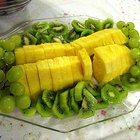
Creatas Images/Creatas/Getty Images
Whether you're preparing a party platter or creating an edible gift, fruit can provide a perfect medium for exquisite artistic sculpture. Cutting fruit can be as simple as dicing clean, even squares, or it can be as intricate as creating a giant watermelon flower. Depending on how you will use the fruit and the amount of time you have to spare, you may want to invest in carving tools, which are available at many chef supply stores. However, for simple designs such as strawberry fans and lemon flowers, you will need nothing more than a sharp knife.
Wash and dry a large strawberry, leaving the green leaves intact. Starting at one side, make several slices about 1/8-inch apart, cutting from the top to just above the leaves but being carefully not to slice all the way through. When you have made the slices, gently spread them apart to make a fan.
Use a melon baller to scoop out spheres of cantaloupe, honeydew, watermelon or other soft, watery fruit flesh. Arrange several different colors together inside the carved-out shell of the melon for a pleasing presentation. You also could carve triangles or curves along the edge of the rind.
Cut the rind off of a lemon or lime, starting at the top and creating a continuous half-inch strip. As you cut, make the strip wavy, slightly thinner and slightly thicker in places. Coil the strip skin-side out as tightly as possible and turn it upside down to create a rose. This also works for tomato skins.
Place a strawberry on a cutting board hull-side down. Make four thin cuts around the sides, creating a square. The cuts should start at the tip and proceed to about halfway down the strawberry, and they should be less than 1/8-inch thick. Be careful not to cut all the way through the skin. Bend the cut sections out away from the center slightly to create a flower.
Cut an apple in half. Trim the sides to create the shape of a leaf. On the skin side, cut two rows of three to four teardrop shapes. Cut tiny triangular shapes into the edges.
Cut off the ends and the skin or rind of an oblong fruit without a center stone, such as a kiwi, pineapple or banana. Cut small grooves lengthwise around the exterior of the fruit. Slice the fruit into 1/4-inch-thick rounds, creating flowers.
Draw designs using a small carving knife into the skin of a fruit, such as a grape, a peach, an apple, an orange or a watermelon. If you use a fruit with a rind, such as a watermelon, remove the hard outer rind, but leave some of the white pith to create contrast. Use gentle but quick strokes to keep the fruit from discoloring, or brush it regularly with lemon juice.
Slice fruit evenly with a clean, sharp knife to create simple shapes, such as cubes or triangles, and arrange the shapes to create a colorful pattern. Cut off the ends of the fruit first, and then cut the fruit in half if you need to remove a pit. Stick the sharp side of your knife into the pit to get a good grip. Then pull the pit out with the knife.
Core fruits a specialized tool, such as a pineapple slicer or a mango slicer, to make cutting easier. Slice fruits with an apple slicer or an avocado slicer to yield equal pieces with clean cuts. To slice a mango or other similar fruits into clean cubes, slice the flesh off of the pit, and score the flesh into cubes. Bend the skin inside out and slide the knife along the skin, letting the cubed flesh fall into an appropriate receptacle.
Related Articles

Techniques for Carving Fruits & ...

How to Make a Silk Calla Lily ...

How to Make a Fruit Tray for a Wedding

How to Preserve Mangoes

How to Make a Lime Peel Garnish

How to Remove Peach Fuzz

How to Make a Wedding Flower ...

How to Dry Pineapple in a Dehydrator

How to Cut Hair Into Chunky Layers
How to Freeze Papaya

How to Stud an Apple

How to Make Whipped Cream Filled ...

How to Make a Nosegay

How to Freeze a Prickly Pear Cactus

How to Make a Teardrop Buckram Frame

How to Eat a Kiwano Horned Melon
How to Clean a Kiwi so the Skin Is Safe ...

How to Make a Baseball Bridal Bouquet

Fruits to Serve With Prosciutto

How to Prevent Bananas From Browning ...
References
Resources
Writer Bio
In 2008 Amanda Gronot began her professional career as a writer for a research company. She helped ghostwrite a book for a prominent CEO and has had essays and translations published in the prestigious classics journal "Helicon." Gronot graduated with a four-year Master of Arts/Bachelor of Arts in classics from Yale University.
Photo Credits
Creatas Images/Creatas/Getty Images